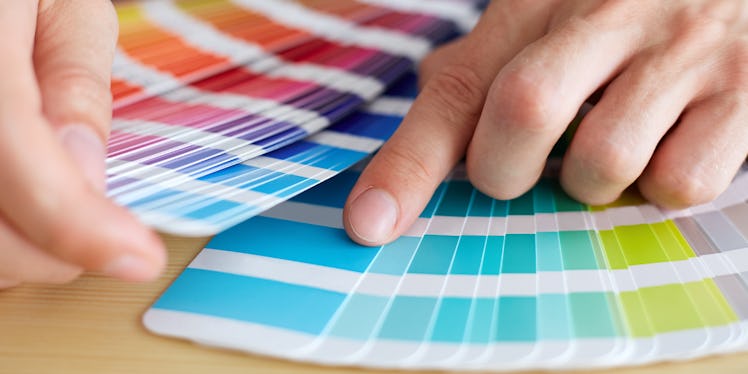A Scientist and a Designer Walk Into a Nursery: How to Pick the Best Color for a Baby’s Room
To create a soothing sanctuary for sleep, consider the effects of various hues. Then grab a paintbrush.

The following was produced in partnership with Fisher-Price, who enrich the lives of young families with gear like the Soothing Motions™ Bassinet, which has everything to soothe and comfort your baby and ensure you both get a good night’s rest.
When decorating a nursery, one doesn’t simply layer on “paint.” One hems. One haws. One considers norms and other people’s unsolicited opinions about gender and culture. Eventually (hopefully), one settles on a color that’s somehow cheery, relaxing, inspiring, and conducive to sleep. That’s not just for the kid, by the way. They don’t get to have any opinion on the matter at first. It’s just as much for the parents, who will spend many hours over the first few years chilling cribside. The nursery paint color must therefore simultaneously inspire wonder at the miracle of life and obscure poo stains. That’s a lot to ask of latex.
So, do what parents do and overthink it with a bit of help from the experts. Design with Science principal Sally Augustin, Ph.D. is happy to help.
“A baby’s vision becomes more acute over time,” she explains. “Initially, I’m more concerned about creating a relaxing space for the parents.”
Cool. Got it. Oh, wait, here comes a designer.
“A kid’s room is their own personal space,” says Maria Killam of Colour Me Happy, who consults for Benjamin Moore and teaches classes on color theory. “We want our kids to be happy so we give a little extra effort to find a color that kids love.”
Okay, so the scientist and the designer don’t quite agree on who the nursery paint job is primarily for. That’s fine. Because they do agree on the effects of certain colors that parents should consider as they seek to craft a relaxing sanctuary for their children as well as themselves. Better to break it down that way.
GreenWhat the Experts Say: Research has linked green to calming effects and enhanced creative thinking, making it an ideal bedtime story backdrop. Calming effects to soothe them to sleep and a creativity boost for you to iron out that tugboat voice you’ve been workshopping.Choose Your Hue: “Relaxing colors are relatively bright, not saturated,” Augustin says. “Sage green mixed with a lot of white is grayer than kelly green and more relaxing. Kelly green is a truer green, not very bright, and more energizing.”
Yellow What the Experts Say: Despite the grand tradition of drawing a happy face on the sun (that’s going on the fridge!), yellow is the world’s least favorite color. “People love it or hate it–there’s no middle ground,” Killam says. But because it’s considered gender neutral (along with green), people still frequently paint nurseries yellow. It can work, but it takes some finesse.Choose Your Hue: “The standard myth is, put yellow in a baby’s room and the baby will cry,” says Killam. “Well, yellow is the first color the eye can see, so, sure, that will be true if you use a primary yellow. We would all cry if we painted our bedrooms that color.” The trick is to go with a lighter, creamier shade. Plus, using colors that are closer to white, in general, affords flexibility when decorating the rest of the room.
BlueWhat the Experts Say: If yellow is hated, blue is universally loved. The association with scenic ocean vistas and peaceful cloud-gazing gives it a calming effect. “We have positive cultural associations to [blue]. We associate it with rest and trustworthiness,” says Augustin. If you’re wavering between colors, go with blue.Choose Your Hue: No one shade is best. Augustin advises, “If you’re stuck, go with a powdery or grayed-out light blue. You’ll be happy.”
WhiteWhat the Experts Say: Besides being a stain magnet, white is uninspiring. “[That much] white is understimulating,” Augustin argues. “You see this problem in hospitals. Painting a room entirely white can be disorienting.”Choose Your Hue: Use white to soften bright colors like yellow. Otherwise, reserve stark white for hard finishes like baseboards.
RedWhat the Experts Say: Red gets everyone fired up–not exactly bedtime vibes. “Bright red, like fire truck red, is particularly energizing,” cautions Augustin. We’ve evolved to associate the color with an emergency or danger.”Choose Your Hue: There is still a place for red in the home. “Red does give us a burst of strength, so if you have a weight room, then paint a wall red,” says Augustin. Now drop and gimme 20.
OrangeWhat the Experts Say: Orange and yellow are the mutants at Table 9 of the rainbow–nobody loves ‘em. The difference is that while yellow is simply reviled, orange is associated with poor quality, like a sale tag in a bargain bin or a New York Knicks uniform.Choose Your Hue: Augustin says to use orange as an accent color in accessories like stuffed animals or picture frames. Go with a pumpkin shade.
Undecided
What the Experts Say: Paint color indecision is a common struggle, but starting with a blank slate is a terrible idea.Choose Your Hue: Find a rug, piece of furniture, piece of art, or general theme you like and use it as a jumping-off point. Just pick something. “It’s hard to get excited about paint colors when you pick one at random and don’t have a piece of art or a carpet or anything,” Killam says. “The minute you choose a color that relates to something in the room, you’re sold.”
This article was originally published on